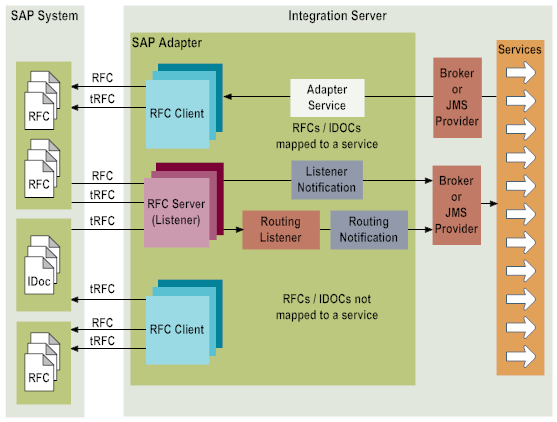Term | Description |
BAPI | Business functions in an SAP system that are written in the programming language ABAP. BAPIs are formalized RFCs. Systems remote from the SAP system commonly use BAPIs to have the SAP system perform an action. |
RFC Server (Listener) | SAP terminology for a process that can accept Remote Function Calls (RFCs) from SAP systems. This allows SAP systems to access functions on external systems. In Adapter for SAP terminology, this is a listener. Listeners are one or more threads on Adapter for SAP that wait for incoming requests from SAP systems. Listeners are named and registered with an SAP gateway to indicate that they are ready to accept requests. Listeners can accept RFC or tRFC requests. |
RFC Client | SAP terminology for a process that sends RFCs to an SAP system to invoke functions. |
tRFC (Transactional RFC) | Protocol for ensuring that an RFC is successfully executed and executed exactly once on the target system. Adapter for SAP can handle both inbound and outbound tRFCs. |
bgRFC (Background RFC) | Protocol for background and queued transactional processing. Adapter for SAP handles inbound bgRFC calls from SAP. Note: To use the support of bgRFC, install webMethods Adapter for SAP Fix 1 and later. |
tRFC protocol | Communications method that: The transactional RFC (tRFC) protocol ensures that an RFC is successfully executed and that it is executed exactly once. |
TID | Transaction ID. A globally unique identifier used by tRFC to ensure exactly one execution. Can be up to 24 alphanumeric characters in length. |
RFC | Requests that the SAP system initiates to have functions performed on remote systems, or calls remote systems initiate to have the SAP system perform a function. |
RFC protocol | Communications method that the SAP system uses to synchronously and asynchronously invoke a function on a remote system, and a remote system uses to synchronously and asynchronously invoke a function on the SAP system. |
Service | Integration Server functions that are named with a hierarchical folder/service syntax. Services can be flow, Java, or C/C++ developed by you, third-party vendors, or provided with webMethods components. |
JCo 3 Library | Code library provided by SAP allowing third parties to integrate the RFC protocol into applications. This is how Adapter for SAP communicates with the SAP system. |
IDoc (Intermediate Document) | EDI-like SAP business document. |
Routing Listener | A process that accepts messages and routes them to a configured location, for example, messages can be routed to an SAP system, another Integration Server, or a remote URL in an XML format. Note: If you need to use a routing listener, you do not need to create one. Adapter for SAP includes a pre-configured routing listener called wm.sap.internal.ls:routingListener. For more information about the routing listener, see Overview. |
Local Transaction Store | A repository that Adapter for SAP uses to track all transactions that pass through Adapter for SAP. |
Centralized Transaction Store | A centralized repository maintained by the CTS server that Adapter for SAP uses to track all transactions that pass through all the adapters of Adapter for SAP group. |
Shared Transaction Store | A common shared repository that Adapter for SAP uses to track all transactions that pass through all the adapters of Adapter for SAP group. |

